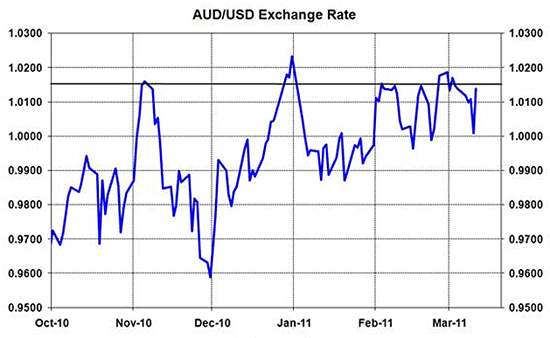

By Roger J Kerr
The NZD/USD exchange rate has rebounded upwards by one cent from the low of 0.7330 reached after the official interest rates were cut by 0.50% by the RBNZ on 10 March.
The initial market reaction to sell the NZD down from 0.7400 on the 0.50% OCR cut announcement was understandable as the moneymarkets were only pricing-in a 60% probability of a full 0.50% reduction.
However, the FX markets have rapidly moved on from domestic interest rates determining the NZD direction and have since returned to the main driving factor - what the Australian dollar is doing.
Following an upbeat assessment of the outlook for the Australian economy by the RBA, the Aussie has again appreciated back upwards against the USD to $1.0150.
The A$ has encountered resistance as these levels previously over recent months (see chart below) and it is something of a surprise that it has been bought back up.
Recent economic data out of China has not been as strong as the markets were expecting and the CRB Commodities Index has recoiled from highs of 365 to 352.
Lower commodity prices and less than positive Chinese economic data is normally quite negative for the AUD against the USD, so the recent gains to $1.0150 may be short-lived.
It will take a significant sell-off in global hard commodity price to force the AUD down from here. That commodity market selling can only come from the following sources:-
- Chinese demand slowing down and the speculative element deciding to take their profits.
- Fund managers who have been large buyers of commodities as an asset class over recent years deciding to reduce their weightings to the over-heated commodities markets.
- The high oil prices slowing global economic growth and reducing commodity demand.
- US short-term interest rates increasing to end the free financing carry on holding commodity inventories, however that appears to be more of a 2012 story at this point.
An overdue downwards correction in global commodities markets could come from any of these factors. The Kiwi will follow the Aussie dollar down if and when it does occur.

Markets seriously question the USD
What is also surprising in the global currency markets is the inability of the USD to make gains against the Euro when European sovereign debt problems are in focus again and US economic data continues to be very positive.
The indecision about the near term direction of the USD itself could be related to mixed messages or the mixed interpretation by the markets of messages coping out of the US Federal Reserve.
It seems that there is a growing chorus within the Fed not to extend the QE2 monetary stimulus that expires at the end of June.
However, recent statements from Governor Ben Bernanke hinted at the continuation of monetary stimulus for the US economy.
The manufacturing, services and consumer confidence economic data suggests that the US economy is starting to progress under its own steam and therefore does not require any additional propping up. Further easing moves from the Fed Reserve is negative for the USD, whereas evidence of self-sustaining expansion is positive for the USD because at some stage US short-term interest rates will need to be increased again.
For the meantime, the FX markets have come to an impasse, not prepared to sell the USD above $1.4000 against the Euro, however also not prepared to buy the USD aggressively in case Bernanke prints more dollars. The latter outcomes does seem unlikely, therefore the view is that the USD will make gains against the Euro over coming months and this should push the NZD/USD rate towards 0.7000.
The Japanese earthquake is not necessarily negative for the Japanese Yen, as like Christchurch, the rebuild will eventually require buying of Yen as international re-insurance monies are remitted into Japan. The Japanese Government will be issuing more debt to global bond markets; so long term Japanese interest rates may rise over time.
In the short-term, emergency monetary measures to ensure liquidity in the markets should be Yen negative. The Bank of Japan will intervene in the foreign exchange markets if the Yen starts to strengthen. The Australian dollar does follow JPY movements against the USD; therefore any early Yen weakness on lower Japanese and Asian equity markets may pull the AUD down against the USD over coming weeks.
The NZ Government’s budget in May will be the next focus of the local FX market, with Finance Minister Bill English working hard to please the credit rating agencies as well as voter expectations.
Before that, the December quarter’s GDP figure on 24 March may cause NZD selling if it is a negative number.
--------------------
* Roger J Kerr runs Asia Pacific Risk Management. He specialises in fixed interest securities and is a commentator on economics and markets. More commentary and useful information on fixed interest investing can be found at rogeradvice.com
No chart with that title exists.

We welcome your comments below. If you are not already registered, please register to comment.
Remember we welcome robust, respectful and insightful debate. We don't welcome abusive or defamatory comments and will de-register those repeatedly making such comments. Our current comment policy is here.